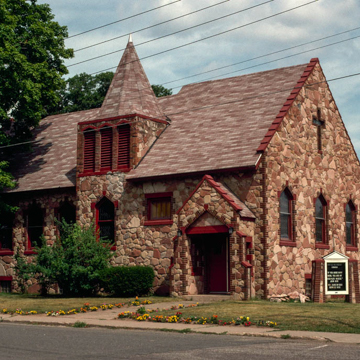In 1951, after the operations at Henry Ford's (earlier Hebard's) sawmill declined, this Gothic Revival church, built originally in pine as the Union Church by Charles Hebard (1831–1902) at Pequaming, was moved from the forest to L'Anse. Here it was veneered with water-washed reddish-brown Lake Superior beach stone in a manner distinct to this locale and trimmed with red brick. This technique may be attributable in part to the skills of the craftsmen who resided in this area and who took advantage of the artistic possibilities of the abundant beach stones. Certainly it conveys their interest in the rocky land. The 150-seat, aisled interior remains unchanged. A house veneered with smooth water-washed and polished brownstone stands at 206 Broad Street. A motel, gas station and garage, fraternal hall, and the chimneys of many houses are clad with beach stone.
You are here
United Methodist Church
If SAH Archipedia has been useful to you, please consider supporting it.
SAH Archipedia tells the story of the United States through its buildings, landscapes, and cities. This freely available resource empowers the public with authoritative knowledge that deepens their understanding and appreciation of the built environment. But the Society of Architectural Historians, which created SAH Archipedia with University of Virginia Press, needs your support to maintain the high-caliber research, writing, photography, cartography, editing, design, and programming that make SAH Archipedia a trusted online resource available to all who value the history of place, heritage tourism, and learning.











